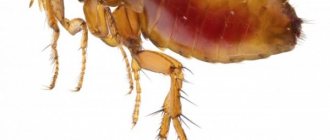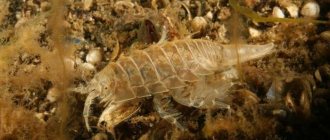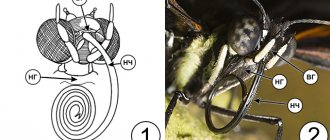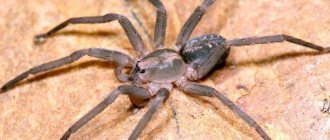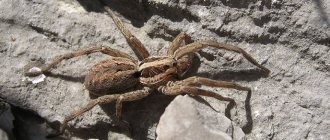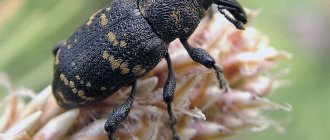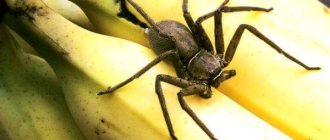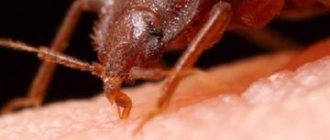Any housewife knows that improper processing of food can lead not only to a deterioration in the taste of the dish, but also to health problems for those who eat this dish. For example, fish often contains various worms, which are quite dangerous for humans to eat.
To avoid unpleasant consequences, you need to know how to determine the presence of parasites and how to properly process and cook fish.
Types of parasites
Various worms can be found in live fish. It is very useful to know what parasites look like, how they can be detected, which of them pose a serious threat to human health, and which are practically harmless.
Wide tapeworm
These helminths are quite common in fish. The parasite belongs to a type of flatworm, a class of tapeworms. It can reach a size of several meters. In fish, it is most often found in the liver or muscles. In the human body it parasitizes in the small intestine. The disease is caused by diphyllobothriasis.
Tapeworm
Cat fluke
The parasite, which belongs to flatworms, begins its development in the body of freshwater snails. Then it leaves the host’s body and, once in a reservoir, enters the fish’s body, where it develops in muscle tissue. Often found in carp, carp, roach, and cod. Once in the human body, it grows, releasing toxins in the process of life, which causes the patient’s immunity to decrease and their general well-being to deteriorate.
Beltworm
Ligulidae is also called tapeworm. This white worm develops in the abdominal cavity of the fish. As it grows, the internal organs of the fish are increasingly compressed, which causes a disruption in their normal functioning.
On a note! Due to damage to the swim bladder, fish often cannot dive into the water and float on the surface.
As a result, the infected individual stops growing. These worms are most often found in pink salmon, bream, and rudd.
Schistocephamos and phylometra
Schistocephamos is a worm from the genus trematodes. This is a small worm, similar in appearance to a tapeworm. Most often they parasitize smelt or crucian carp.
Philometra are thin red worms reaching a length of 10–15 cm. Most often they parasitize on the scales in the head area, under the gills.
These parasites in fish are not dangerous to humans.
Trienophorus nodulosus and Cystidicolafarionis
Trienophorus nodulosus are helminths that live in the liver of fish (most often burbot). Recognizing the parasite is quite simple. The worm itself is 7-8 cm long and lives in a capsule in the form of a small light ball. After careful removal of the liver, the fish is absolutely safe for humans.
Cystidicolafarionis - parasitizes the swim bladder of river fish, such as perch, pike perch, and smelt. During the cleaning process, the fish's innards are removed, after which the product can be eaten without harmful effects on health.
Anisakid
These helminths are nematodes and most often infect marine fish. They can be found both in the body cavity and in muscle tissue, most often in a coiled state. Worm larvae, depending on the species, are yellowish or red in color. Once in the human body, fish worms penetrate the digestive tract, where they attach to the mucous membrane, provoking the development of an inflammatory process.
Safe types of parasites
Some types of worms that parasitize fish do not pose a danger to humans. These varieties include:
- diplostoma (flatworms) - mainly affect the gills, eyes, pectoral fins;
- polymeters (roundworms) - in males they parasitize inside the swim bladder, in females in scaly pockets;
- several types of tapeworms, including the common Ligulidae , a white worm that lives in the stomach of fish.
Worms in fish
These helminths are not parasitic in the human body. Moreover, if the fish is properly cleaned before cooking, all parasites will be removed.
Parasites in fish - photos of the most popular species and name
There are different types of worms in fish. Some of them are completely safe for humans, but others can cause great harm to health. The most common among those dangerous to humans are:
- Echinococcus is a tapeworm type, small in length. They are able to live in the human body only in an intermediate form.
- Siberian fluke - the shape of the helminth is flat, the length is a maximum of 12 mm. Mainly helminths live in river species. When it enters the human body, it causes the disease opisthorchiasis.
- Wide tapeworm - settles in the intestines in the form of a larva, which gradually grows. This parasite can reach a length of 12 meters. In case of infection with this type of helminths, people have one or two parasites. But in medical practice there have been cases where a significantly larger number of worms were diagnosed.
- Nanophyetosis is a small yellow-gray nematode.
- Trematode is a helminthic infestation 2.5 cm long.
- Anisakids are among the most dangerous worms that parasitize fish.
There are types of helminthic infestations that do not harm human health and condition. These include:
- Pilometra are red worms that can reach 20 cm in length. It usually lives in the pockets of the scales, so that when the fish is thoroughly cleaned, the worms are removed and the product becomes suitable for consumption.
- Diplostomas - such parasites choose a location near the eyes. The larvae are visible to the naked eye. They pose no danger to humans.
- Ligula or Ligula ordinary - refers to tapeworms that infect the body of fish. There is no danger to humans from such parasites. The main purpose of the helminth is to enter the stomach of birds that feed on fish. There the larvae grow and lay eggs, which the bird then spreads over the sea through excrement. Birds also do not suffer from this type of worms.
- Posthodiplostomum minimum is a tapeworm that parasitizes fish. The main hosts are considered to be birds and amphibians; it is not dangerous to humans.
The most susceptible fish species to infection
Although any fish can be infected with worms, some species are more susceptible to infestation. For example, parasites are found much more often in river and lake fish. The varieties most susceptible to parasite infestation include:
- crucian carp;
- perch;
- ide;
- bream;
- tench;
- pollock;
- flounder.
Depending on the type of parasite, fish may contain eggs, larvae, or adults. Preparing dishes from fish, which is likely to be contaminated, requires particularly careful cleaning and high-quality heat treatment.
How does helminth infection occur?
Parasite eggs attach to the stomach. Thanks to the presence of a sticky substance, they cling securely, and it is quite difficult to tear them off the fish. This makes the likelihood of infection high.
There is only one method of infection - eating fish infected with parasites that has undergone poor quality or insufficient heat treatment. Most often, the problem can occur when consuming the following types:
Sea fish contain worms. Mostly, the inhabitants of the seas are infected with anisakid larvae. Therefore, when eating such products, it is very important that they undergo high-quality heat treatment or are frozen at low temperatures before consumption. Of course, the taste changes when frozen, but safety is more important.
What do helminths look like in fish?
Worms that can develop in fish belong to different species, therefore they differ in size, color, and location. It is not always possible to see worms, since sometimes their size reaches only a few millimeters, and they are located in the internal organs, muscles, and gills. The most difficult thing to notice with the naked eye is the larvae, but it is they who pose the greatest danger to humans. Adult helminths most often curl into a spiral or ring.
In order to make sure of the presence of worms, when cutting fish, you need to carefully examine it. But it is not necessary to find the parasites themselves. It is enough to know what fish infected with worms looks like. Most often, the surface of her body is uneven, with bumps and swelling. The color is uneven, with darkening, the eyes are cloudy.
Danger of worms in red fish
The most popular delicacy is red fish. It is used in various exotic salads, and it is invariably used to make sushi. In such dishes, the fish may be lightly salted or even raw. It is in this case that a great threat to human health lurks, since fish can be parasitized by various types of helminths - large worms that reach large sizes when they enter the human body.
The most popular carriers of large worms that are dangerous to humans are chum salmon and pink salmon. They can be parasitized by the dangerous helminth tapeworm, which causes helminthic infestation. The larvae of the parasite are white and resemble rice. They are located in the gastrointestinal tract of fish, can affect the liver and penetrate muscle tissue. Once in the human body, the larvae transform into an adult, which can reach large sizes (up to 15 m).
White worms in red fish can cause acute poisoning of the body in humans, which manifests itself in the form of vomiting, indigestion, headaches, disorders in the digestive system, and allergic rashes throughout the body.
Diseases carried by infected fish
According to research, both red and white fish, even the noblest breeds, can be infected with parasites. If anyone has any doubts about whether worms in fish are dangerous for humans, just read the list of diseases caused by worms:
- diphyllobothriasis - its causative agent, the broad tapeworm, enters the human body at the larval stage, and then develops and lives in the intestines, causing digestive problems;
- clonorchiasis - the disease is caused by Chinese fluke entering the body, the parasites provoke disruption of the liver, pancreas, and bile ducts;
- nanophyetosis - parasites settle in the intestines, exerting toxic-allergic and mechanical effects on its tissues;
- opisthorchiasis - occurs after the Siberian fluke enters the body, over time leading to an enlargement of the liver and spleen;
- Anisakidosis - eggs and larvae of worms, once in the human body, provoke the development of gastrointestinal diseases;
- Metagonimiasis - small worms, parasitizing in the intestines, cause digestive problems, stomach pain, and vomiting.
Stomach pain
If treatment is started in the early stages, the prognosis for all diseases is favorable. The problem is that the symptoms do not appear immediately and are classified as non-specific, which makes diagnosis difficult.
Determining the presence of parasites in fish
Most worms in fish can be seen with the naked eye. Even small-sized helminthic infestations cannot hide from the housewife’s gaze when cutting up the product. If necessary, photos that are presented on many resources will help you study worms in fish.
But it is very difficult to find worm larvae in the product. This is usually only possible through laboratory testing.
If you find helminths in fish, you should not eat such a product. If worms are not found when cleaning sea or river fish, this does not eliminate the need for high-quality heat treatment of the product.
Is it possible to eat fish with worms?
According to existing sanitary standards, fish infected with certain types of helminths is considered conditionally suitable for consumption. This means that if parasites are found in raw fish, it can be eaten after appropriate processing.
On a note! A person will not become infected with worms from well-fried or boiled fish, as they will die from high temperature. The same can be said about well-salted fish; it is almost impossible to become infected with roundworms or other helminths from it.
But no one has canceled such a completely natural feeling as disgust. Not everyone will agree to eat wormy fish, even knowing that it is safe and all the parasites in it have died.
Worms in fish that are dangerous to humans
Do not forget that only a small percentage of parasites found in fish are not dangerous to humans. Eating raw or semi-raw foods can lead to serious complications.
Parasites found in both freshwater and sea fish that are dangerous to the body:
- Clonorchis;
- Anisakids;
- Opisthorchis;
- Diphylobothrium.
Clonorchis and opisthorchis
They belong to the order of flatworms (trimatodes), the main habitats of this parasite are mollusks. Among river inhabitants it is found in the carp family (carp, roach, bream, carp, etc.).
Smaller individuals of this parasite also live in small fish; subsequently they can be found in animals and birds that have consumed infected meat.
Parasites of the subspecies of trimatodes perform the function of flukes, sticking to the walls of the stomach of fish, animals or birds, which leads to further death of parts of the stomach and tissue necrosis in general.
Trimatodes are predominantly red in color and reach a length of 10 cm (large worm) and 2-3 cm (small parasite).
Anisakids
The most harmful parasites living in fish. They are considered the most dangerous worms for the human body due to their transient parasitism.
Anisakids are divided into two types:
- Anisakissimplex
- Pseudoterranova
Anisakissimplex – better known as the herring worm, is primarily found in pollock, mackerel and herring.
Pseudoterranova - cod worms, differ from the first species in smaller size and are found exclusively in cod. This type of parasite is resistant to low temperatures; even living specimens of this worm were found in a frozen carcass. The site of parasitism is predominantly the liver.
They enter the human body through consumption of improperly prepared, raw or lightly salted fish.
Diphyllobothrium
There are 3 types of cestodes that can infect the human body:
- Latum;
- Dendriticum;
- Nihonkiense.
The most dangerous latum is better known as the broad tapeworm. It is one of the longest worm-like parasites. The length of the parasite reaches 10 meters, life expectancy is 20 years.
The parasite grows by changing its owner. The first habitat of the tapeworm larvae are crustaceans or small individuals, then the maturation of the parasite individual can occur together with the maturation and growth of its inhabitant, or when the host eats larger fish.
Even in a large fish, the parasite may be in the larval stage and when it is cut, the parasite may not be noticed. Therefore, it is not recommended to eat raw or semi-raw fish.
How to protect yourself from parasite infection?
Having bought fish even in the most expensive store, you can never know 100% whether there are worms in it. Therefore, to avoid eating food contaminated with parasites, it is necessary to select and process fish correctly.
The following recommendations will help you enjoy deliciously cooked fish and avoid becoming infected with helminths:
- When purchasing, you need to carefully inspect the carcass; you should refuse fish with dark spots on the skin, loose meat, cloudy or missing eyes;
- during cleaning, you should pay special attention to the insides; most often the parasites are localized there;
- to destroy parasites and their eggs, the fish must be heat treated (cook for at least half an hour, fry for at least 20 minutes, bake whole for at least 40 minutes);
- in fish frozen at -20⁰С, parasites die after 2 days, at -4⁰С - within a month;
- When salting, you must use a concentrated salt solution and keep the fish in it for at least 15 days.
Well, of course, it all depends on the degree of infection. If your fish is infested with worms, the only thing to do is to get rid of it as soon as possible without any doubt.
Helminth development
Tapeworms in fish can reach a length of up to 25 cm and cause serious illness. The body consists of segments, which, after maturation, separate and are capable of independent existence. A special feature is that the worm is capable of producing male and female reproductive cells at the same time. They are attached to the walls of the internal organs using suction cups, which are located on the front of the body.
The broad tapeworm can lay up to several thousand eggs per day. The lifespan of each individual can reach 20 years.
The fish tapeworm goes through several stages in its development.
- Fish become infected with larvae by eating cyclops, crustaceans, snails and other small inhabitants of water bodies.
- Fish infected with larvae are caught and eaten by waterfowl.
- Further development of the larvae occurs in the body of the birds, and they, along with feces, again enter the water.
- Particles of feces are again swallowed by small inhabitants of the reservoir, on which freshwater fish feed, and are again infected with tapeworm. But at this stage, larvae form, which can become dangerous to humans.
Most often, fish with white meat are susceptible to tapeworm - for example, bream, roach, pike, sop. As the tapeworm grows, all the internal organs of the fish are compressed. The swim bladder contracts, swimming function is impaired, so the fish floats to the surface and can remain belly up for a long time.
Which fish doesn't have worms?
It is difficult to say for sure which fish are free of parasites, since absolutely all species are susceptible to infection. But there are some categories in which worms are very rare. These include species that live in the open seas or ocean, as well as fish that live in cold waters. Parasites are least often found in the following types of fish:
- sturgeon;
- tuna;
- mackerel;
- catfish
Tuna
You must understand that there are no guarantees and any individual can be infected, regardless of species.
Suppliers of artificially grown fish assure the absolute purity of their products. But whether artificial cultivation guarantees the absence of parasites and how carefully all sanitary conditions are observed in each specific farm is impossible to say for sure.
Which parasites are not harmful?
Despite the possibility of contracting infectious diseases due to the presence of parasites in the fish’s body, not all of them are dangerous to your health.
- Ligula. If this worm is found inside a fish, it is enough to simply remove it. The presence of a helminth in a fish body does not give negative consequences, since it does not have the ability to penetrate muscle tissue and develop vigorous vital activity within it. However, it is better to heat treat the fish if you suddenly find such an unpleasant lodger in its body. Both freezing and boiling the product are suitable.
- Schistocephamos. The favorite habitat of this type of parasite is the intestines of red fish (trout, salmon). Getting rid of them is easy: you just need to know how to clean fish. Clean the fish from the internal organs, but try to make sure that the offal is not found by animals: schistocephamos is a helminth that gets along well in their body.
- Cystidicola pharyonis. Just like the previous parasite, it loves the abdominal cavity. Simply remove the giblets and boil the fish. It does not take root in the human body.
- Trienophorus nodulosus. This type of worm infects the liver of fish. The measures to remove it are the same as in the previous example: clean the peritoneal cavity and boil the fish itself.
- Philometra. This type of worm can hide not only inside, but also under the scales and in the gill area. You will have to clear out illegal settlers manually, and after that it is better to boil the fish. They are not parasitic in the human body. They prefer the carp family.

